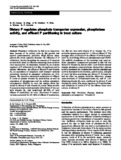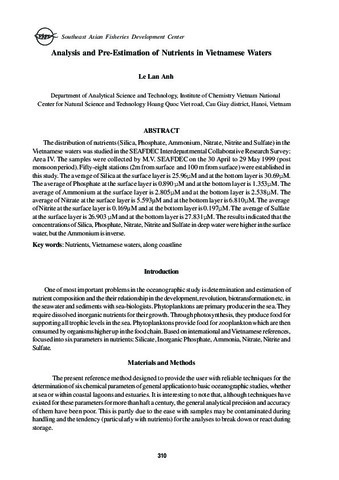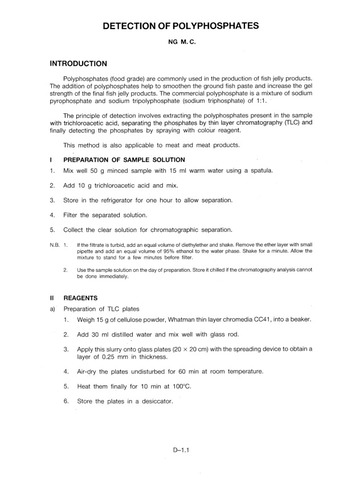Dietary P regulates phosphate transporter expression, phosphatase activity, and effluent P partitioning in trout culture

View/Open
Date
2003Page views
512Metadata
Show full item recordCited times in Scopus
- Citations
- CrossRef - Citation Indexes: 24
- Policy Citation - Policy Citations: 2
- PubMed - Citation Indexes: 3
- Scopus - Citation Indexes: 32
- Captures
- Mendeley - Readers: 31
Share
Abstract
Phosphate utilization by fish is an important issue because of its critical roles in fish growth and aquatic environmental pollution. High dietary phosphorus (P) levels typically decrease the efficiency of P utilization, thereby increasing the amount of P excreted as metabolic waste in effluents emanating from rainbow trout aquaculture. In mammals, vitamin D3 is a known regulator of P utilization but in fish, its regulatory role is unclear. Moreover, the effects of dietary P and vitamin D3 on expression of enzymatic and transport systems potentially involved in phosphate utilization are little known. We therefore monitored production of effluent P, levels of plasma vitamin D3 metabolites, as well as expression of phosphatases and the sodium phosphate cotransporter (NaPi2) in trout fed semipu diets that varied in dietary P and vitamin D3 levels. Mean soluble P concentrations varied markedly with dietary P but not with vitamin D3, and constituted 40–70% of total effluent P production by trout. Particulate P concentrations accounted for 25–50% of effluent P production, but did not vary with dietary P or vitamin D3. P in settleable wastes accounted for <10% of effluent P. The stronger effect of dietary P on effluent P levels is paralleled by its striking effects on phosphatases and NaPi2. The mRNA abundance of the intestinal and renal sodium phosphate transporters increased in fish fed low dietary P; vitamin D3 had no effect. Low-P diets reduced plasma phosphate concentrations. Intracellular phytase activity increased but brushborder alkaline phosphatase activity decreased in the intestine, pyloric caeca, and gills of trout fed diets containing low dietary P. Vitamin D3 had no effect on enzyme activities. Moreover, plasma concentrations of 25-hydroxyvitamin D3 and of 1,25-dihydroxyvitamin D3 were unaffected by dietary P and vitamin D3 levels. The major regulator of P metabolism, and ultimately of levels of P in the effluent from trout culture, is dietary P.
Suggested Citation
Coloso, R. M., King, K., Fletcher, J. W., Weis, P., Werner, A., & Ferraris, R. P. (2003). Dietary P regulates phosphate transporter expression, phosphatase activity, and effluent P partitioning in trout culture. Journal of Comparative Physiology B: Biochemical, Systemic, and Environmental Physiology , 173(6), 519-530. https://doi.org/10.1007/s00360-003-0360-x
Subject
Collections
- AQD Journal Articles [1248]
Related items
Showing items related by title, author, creator and subject.
-
Analysis and pre-estimation of nutrients in Vietnamese waters
Anh, Le Lan (Secretariat, Southeast Asian Fisheries Development Center, 2001)The distribution of nutrients (Silica, Phosphate, Ammonium, Nitrate, Nitrite and Sulfate) in the Vietnamese waters was studied in the SEAFDEC Interdepartmental Collaborative Research Survey: Area IV. The samples were ... -
Nutrient Diagenesis in Sediments of the South China Sea, Area II: Sabah, Sarawak, and Brunei Darussalam Waters
Chareonpanich, Charumas; Seurungreong, Siriporn; Meksumpun, Shettapong (Training Department, Southeast Asian Fisheries Development Center, 1999)Study on nutrient diagenesis and physico-chemical characteristics of bottom sediments of the Sabah, Sarawak and Brunei Darussalum waters had been carried out under the ongoing SEAFDEC Collaborative Research Project. The ... -
Analysis of additives: Detection of polyphosphates
Ng, Mui Chng (Marine Fisheries Research Department, Southeast Asian Fisheries Development Center, 1987)Polyphosphates are commonly used in the production of fish jelly products. The paper provides the methodology in the detection of polyphosphates in fish products. Instructions on the preparation of sample solution and the ...




